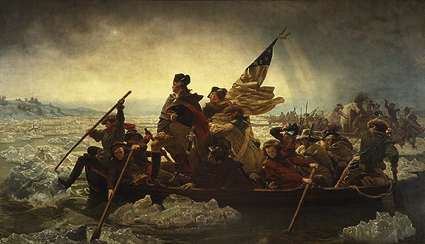Washington Crossing the Delaware

George Washington Crossing the Delaware
by Emanuel Gottlieb Leutze, American, 1816-1868
With the possible exceptions of DaVincis' Mona Lisa and Last Supper, this is perhaps the most universally recognized image in the entire history of art. The original painting which measures 12 ft. x 21 ft. hangs in the New York Metropolitan Art Museum. Here the artist shows General Washington preparing to attack the Hessians at Trenton on December 25, 1776.
Painted in Düsseldorf, Germany around 1851, the artist had lived in America as a boy, and after going back to Germany, had returned to America many times. While here, he visited the Smithsonian and examined Washington’s uniform and sword, and carefully studied paintings and sculpture of the Great General which were done in Washington’s lifetime. Yet, despite this intensive research into historical accuracies, Leutze then let his artistic license run wild. Perhaps that is why this painting is usually classified in the "Romantic" school of art.
The actual crossing was done in the dead of night, during a driving snowstorm, and was completed by 3 AM. Leutze indulged in symbolism showing Washington leading his men out of a stormy darkness into a new dawn of freedom. Above the foremost oarsman, Leutze painted in the morning star, invoking the legend of the wise men following the star at Christmas.
Besides Washington, only two of the figures in the boat have been identified. The man holding the flag is reported to be Lieutenant James Monroe, future president of the United States. He was quartered in the house where Washington made the decision to cross, and served as a scout and trusted adviser to the General, but there's nothing in the historical records to indicate he crossed in the same boat. The other recognizable figure, pulling on an oar at Washington’s knee, is Prince Whipple, a black patriot who has become a minor legend of the Revolution. While many black soldiers served in Glover”s Marblehead Regiment, the unit that ferried the army across the river, Prince Whipple wasn't one of them. In fact, in December of 1776 he was in Baltimore.
The people in the boat represent a cross-section of the American colonies, including a man in a Scottish bonnet in the front, western riflemen at the bow and stern, two farmers in broad-brimmed hats near the back, and the rower in a red shirt, possibly meant to be a woman in man's clothing. I would like to think that the man standing behind Washington is not Madison but our Polish Colonel, Thaddeus Koscuiszko, who advised the General in many of his campaigns, including the attack on the Hessian’s headquarters.
